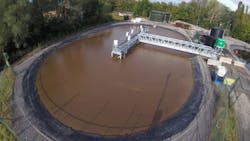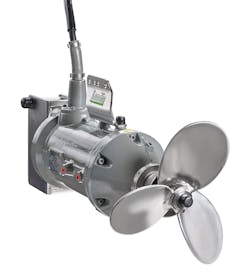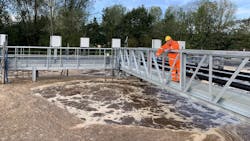Evaluating Mixing & Aeration Equipment for Leachate Treatment Plants
In San Francisco, about half a million tons of material ends up in the city’s landfill every year. Yet this is a city that due to bold public policy and educational initiatives, leads the way in successfully diverting about 80% of its waste from landfills.
Across the US, the figure is more like 34%, so with all that waste, the treatment of leachate from landfill sites remains crucial. This includes thousands of old municipal landfills - now full. In 2009, America had around 30,000 landfill sites. Today, there are just over 3,000. Active or at capacity, all these sites require pumps and mixers for anything between 10 and 30 years – even longer – until the leachate achieves safe consent levels for discharge.
Remains a Big Challenge
Rainfall remains the principal contributor to the generation of leachate, especially at more modern landfills, and as carbonaceous material decomposes, a cocktail of methane, carbon dioxide and a complex mixture of organic acids, aldehydes, alcohols and simple sugars is produced. Precipitation percolates through the waste and takes in dissolved and suspended components from the biodegrading waste, through physical and chemical reactions, but the unpredictability of leachate, especially at older sites, remains a big challenge.
At newer landfills, there should be a reasonable knowledge of what’s coming out because the operator is in control of what’s going in, but although sometimes the variations in liquor strengths isn’t always entirely logical, aging sites will typically produce a weaker leachate, compared to modern sites where the leachate can be extremely corrosive.
Despite much stricter statutory controls, leachates from modern sites are currently stronger than ever. They contain a huge range of contaminants from anything soluble in the waste. Even low concentrations of trace contaminants can have very strong effects. These are nowadays most often derived from materials in household and domestic retail products which enter the waste stream perfectly legally.
The acidity in leachate process sometimes means that lime has been dosed for pH correction, which can cause severe abrasion to equipment, and there are also high temperatures to contend with. The problems are manyfold, but not insurmountable if the right type of system is built in.
Up against all these unknowns, one would think that only the highest grade of equipment would be used to pump, mix and aerate leachate, but this isn’t always the case. As with any equipment that has been wrongly specified or poorly maintained; some mixers can emerge from a leachate tank with very little left of the blades. At a relatively new plant, standard cast iron mixers might only last 12 months, or less! The corrosive liquid has been so strong for so long that it has literally eaten the equipment away. Cast iron mixers, importantly, with an epoxy coating, plus stainless-steel bracketry, can be sufficient, but solid 316 stainless-steel is usually the best, long-term solution.
Two decades ago, internal submersible mixers in a leachate tank were the norm, but today, externally-mounted is far more common. This makes them far easier to service, and improves health and safety by not having to work at height or in a gas zone.
When treating leachate isn’t proving as effective as it should be, there is tendency from some operators to throw more power at it, but just because not enough oxygen is reaching the whole of the tank (usually causing an odor problem), it may be a lack of mixing that is the reason. We recently replaced a 25HP aeration unit with one of our mixers that is just 10HP. Much less power of course, but because it is designed for the application and has a superior impeller design, it keeps the sediment in suspension that the much larger unit was struggling with. Floating aerators can also provide a solution as they comprehensively mix a tank.
Floating biomass can also create big issues at leachate treatment plants. We recently worked with Viridian Systems, for whom sludge taking too long to settle at its customer’s site was drastically reducing throughput.
Completely Eliminating the Problematical Filamentous Bacteria
From sludge taking well over two hours to settle (with unnecessary amounts still floating), it has now been reduced to less than 30 minutes. With the plant set up for two batches per day, this potentially adds back three hours of treatment time per day, which equates to more than 14,000m3/year of leachate that no longer has to be tankered off-site; equating to a staggering annual saving of $380,000.
As Viridian Systems’ Managing Director, Roger Dixon explains, the new mixer (made by Landia) has now completely eliminated the problematical filamentous bacteria.
“To solve the problem for the leachate treatment plant,” he said, “We believed that with the correct type of mixer; suitably positioned, powered and timed, the right amount of agitation would disperse the floating layer to allow solids to settle much more quickly.”
He added: “Undesirable filamentous bacteria, which is one of the main causes of floating biomass, is detrimental to sequencing batch reactor (SBR), but working closely together with Landia, who have vast experience in mixer applications, the subsurface liquor is now degassed; meaning no more floating biomass.”
As the plant began to produce far less unwanted foam, Viridian Systems asked the plant operator to gradually reduce dosing with a defoaming agent (antifoam) until the consumption rate falls to around 1-2 drums/month, instead of 2-3 drums/day, which will not only save around $100,000 but will also reduce the dissolved organics, measured as chemical oxygen demand (COD) in the treated effluent.
Furthermore, the installation of the Landia mixer has also enhanced the reliability of the plant’s dissolved oxygen (DO) (optical) probe, because there is less foam to blind it. With the probe now working as it should, there is better control of the blower speed, reducing its energy consumption, which in turn, offsets some of the power consumed by the mixer.
Viridian Systems’ Roger Dixon also stated:
“Far from just supplying a mixer, Landia shared our goal in wanting to find the best possible solution. What has been achieved provides considerable ongoing benefits for our customer. As a result of this success, we have also installed a Landia mixer in a tank adjacent to the SBR.”
With the possibility that every active landfill in the U.S. reaches its capacity before 2040, there is cause for concern. Countries such as China, to whom America at one point exported huge volumes of recyclable materials to, have banned the import of low-grade plastics and other related materials. The rate at which landfills are being filled is also increasing at a rate far greater than anticipated due to the incredible growth of e-commerce, excess packaging, and an increased consumption of single-use items.
Landfill management has become more restrictive over the years, requiring additional controls and monitoring of leachate runoff and methane gas emissions from decomposition to manage one of the most harmful greenhouse gases. In addition, the permitting process for new landfills has also become more complex and lengthier. A current estimate now is that acquiring a permit for a new landfill may take up to 7 to 10 years, during which time regulations could change, causing increases in cost that are no longer competitive.
In England, Tolvik Consulting calculated that the country has less than seven years left of non-hazardous landfill capacity. This was in 2017!
In the same year, an Environmental Services Association report claimed that by 2030 there will be a household waste capacity deficit of 6 million tonnes.
Given the fast-shrinking availability of landfill sites, is the process of upgrading them so that they can achieve their true capacities not being explored as much as it should be?
A recent example of a successful enhancement was at Yorwaste’s Harewood Whin Leachate Treatment Plant, which has been extensively upgraded by Phoenix Engineering.
Managing over half a million tonnes of waste per year, Yorwaste brought in Phoenix Engineering to carry out detailed process studies, and then to design and construct a major refurbishment of the treatment plant, originally built in 1990. This included the enhancement of a challenging oval-shaped lagoon, which during the winter months was not achieving sufficient biological treatment efficiency.
Jonty Olufsen, Managing Director of Phoenix Engineering, explained:
“We designed a new lagoon arrangement to focus on treating higher strength leachates within the landfill, which were a problem for the previous treatment plant system. During the winter, the existing mechanical floating aerators meant the lagoon could only operate at around 41 degrees Fahrenheit, when to achieve the most effective biological treatment, it should have been more like 68 degrees Fahrenheit.”
Avoiding Clogging in Aerators
Olufsen added:
“It is a complex application due to the oval shape of the (1400m3) lagoon. We worked long and hard with Landia to find the best way to heat the biological mixed liquor and keep it warm during the winter months. It was imperative that the contents of the lagoon would be aerated and mixed properly.”
Comprising a Landia Chopper Pump and venturi nozzle, four Landia 18.5kW AirJets were installed to provide thorough mixing and aeration. With its knife system, the Landia Chopper Pump ensures that the aerator does not get clogged due to contaminants in the leachate.
During the settlement period of the leachate treatment plant, any movement in the lagoon had to be stopped as quickly as possible before the start of the next cycle to ensure a suitable time for settling.
So, in the approximately 42 meter x 24 meter lagoon, a 3kW submersible propeller mixer from Landia was also installed. This small mixing unit runs for just a short time – only starting up when the AirJets stop. Aimed against the flow, the propeller mixer’s job is to act as a brake, slowing down the movement in the lagoon.
Olufsen continued:
“With this combination from Landia, the result is that excellent three-dimensional mixing is in place. From the previously unsatisfactory temperatures of around 41 degrees Fahrenheit, with the old mechanical floating aerators a consistent temperature of around 68 degrees Fahrenheit is maintained throughout the winter, making the biological process very efficient.
The second lagoon (also 140 feet x 80 feet with rounded ends) has been converted for raw leachate balancing, allowing for controlled blending of incoming leachates. For both lagoons, full process controls have now been installed, with a new sodium hydroxide storage and dosing system for pH control.
Previously, the plant was predominantly a manual operation, with very little process automation or data acquisition or recording, and no automated pH control option. Now though, as Principal Contractor, Phoenix Engineering’s full design and refurbishment, has seen the installation of a completely new electrical control and automation system with control building, remote IO, and control panels. All new process instrumentation was fitted, with the whole plant now linked back remotely to Phoenix Engineering’s DLOG (digital logbook).
Seed sludge from a number of leachate treatment plants around the country was sourced by Yorwaste, with support from Phoenix Engineering for biological commissioning provided toward the end of 2019. The two companies also worked together to source and deliver new duty/standby pump skids. These were fabricated, built, and tested at Phoenix Engineering’s workshop, then delivered and installed on-site.
The Leachate Treatment Plant Refurbishment included a new gantry arrangement for access to, and to support new control panels, instruments, and aerators.
Speaking for Yorwaste, Callum Duff, Landfill Restoration, and Aftercare Manager said:
“As well as ensuring that we recycle and recover as much as possible of the material we collect, we also take our responsibility to the environment seriously, so we carried out a lengthy search for the right people to partner with for the upgrade of our Harewood Whin Leachate Treatment plant.”
Duff added:
“From start to finish, Phoenix Engineering worked with us to deliver a first-class refurbishment. With the Landia, Inc. aerators and mixer, they have shown their keenness and capability to ensure that the leachate is treated with optimum efficiency.”
There’s no stopping rain (and snow) as it adds to new and existing volumes of trash at landfills, so accumulated leachate will continue to require treatment for many years to come - so in the absence of new landfills being built or extended, could a review of your site’s existing mixing and aeration equipment help provide some much-needed extra capacity?



